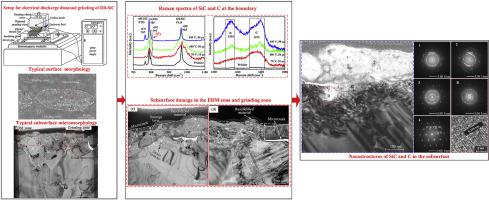International Journal of Machine Tools and Manufacture ( IF 14.0 ) Pub Date : 2020-04-21 , DOI: 10.1016/j.ijmachtools.2020.103564 Xiaoshuang Rao , Feihu Zhang , Yanjun Lu , Xichun Luo , Fumin Chen

|
Reaction-bonded silicon carbide (RB-SiC) ceramic, one of the best candidates for large optical mirrors, is difficult to machine because of its high hardness and brittleness. A hybrid process called electrical discharge diamond grinding (EDDG) exhibits potential for improving the machinability of RB-SiC by combining electrical discharge machining (EDM) and diamond grinding. However, this hybrid process leads to damages that differ from those in conventional processes owing to the simultaneous actions of EDM and diamond grinding. In the present study, surface and subsurface damages induced by the interactions between EDM and diamond grinding during the EDDG of RB-SiC were examined. The effect of the discharge energy was considered. The surface and subsurface topographies and microstructures were characterized via scanning electron microscopy, Raman spectroscopy, and transmission electron microscopy. The EDM and grinding zones exhibited distinctive surface topographies and different dominant material removal mechanisms. An increase in the discharge energy facilitated ductile removal of the material and decomposition of SiC. Thus, a thinner subsurface damage layer was obtained compared with that in the less-thermally affected zone. The decomposed C and material migration tended to increase with the discharge energy. Owing to the interactions between EDM and diamond grinding, the subsurface was a mixture of amorphous/crystalline C, polycrystalline/nanocrystalline SiC, and a crystalline SiC matrix.
中文翻译:

放电金刚石磨削引起的反应结合碳化硅的表面和亚表面损伤
反应粘合碳化硅(RB-SiC)陶瓷是大型光学镜的最佳候选材料之一,由于其高硬度和脆性而难以加工。通过将放电加工(EDM)与金刚石磨削相结合,一种称为放电金刚石磨削(EDDG)的混合工艺具有改善RB-SiC切削性能的潜力。但是,由于电火花加工和金刚石磨削的同时作用,这种混合工艺导致的损坏不同于传统工艺。在本研究中,研究了由RB-SiC的EDDG过程中EDM和金刚石磨削之间的相互作用引起的表面和亚表面损伤。考虑了放电能量的影响。通过扫描电子显微镜对表面和亚表面形貌和微观结构进行了表征,拉曼光谱和透射电子显微镜。EDM和磨削区表现出独特的表面形貌和不同的主要材料去除机制。放电能量的增加促进了材料的韧性去除和SiC的分解。因此,与受热影响较小的区域相比,获得了更薄的地下破坏层。分解的碳和材料迁移趋于随放电能量增加。由于EDM和金刚石磨削之间的相互作用,其下表面是非晶/晶体C,多晶/纳米晶体SiC和晶体SiC基体的混合物。放电能量的增加促进了材料的韧性去除和SiC的分解。因此,与受热影响较小的区域相比,获得了更薄的地下破坏层。分解的碳和材料迁移趋于随放电能量增加。由于EDM和金刚石磨削之间的相互作用,其下表面是非晶/晶体C,多晶/纳米晶体SiC和晶体SiC基体的混合物。放电能量的增加促进了材料的韧性去除和SiC的分解。因此,与受热影响较小的区域相比,获得了更薄的地下破坏层。分解的碳和材料迁移趋于随放电能量增加。由于EDM和金刚石磨削之间的相互作用,其下表面是非晶/晶体C,多晶/纳米晶体SiC和晶体SiC基体的混合物。











































 京公网安备 11010802027423号
京公网安备 11010802027423号